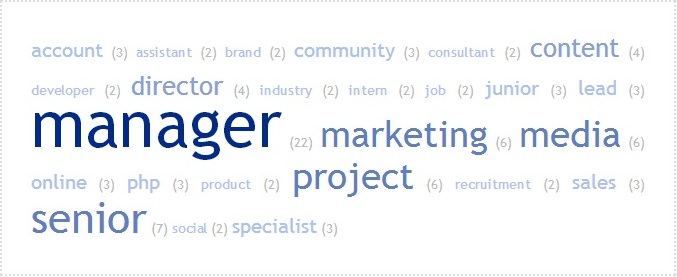Analyzing “new media” job postings in The Netherlands

The New Media and Digital Culture MA at the UvA attracts a significant number of international students to Amsterdam every year since its initial academic year in 2006. Assuming that some of these students would like to pursue a professional career in The Netherlands, what kind of challenges should they be prepared to face in the local job market? What are the most common job titles in which industries and what are the standard requirements to work in a “new media” related area in 2012?
The search and its premises
Having these questions in mind, I decided to undertake a minor study [1] using the professional networking platform LinkedIn. I defined several premises upfront to be able to delineate a sample: 1) I would consider job opportunities in the whole country (not just specifically in Amsterdam), 2) I would only consider offers presented in English and 3) I would not search for specific functions or industries.
 I initiated the process by searching for “new media” as one keyword under the Job Search functionality. This action retrieved six results, five of them in English. In an attempt to broaden the scope of the results, I then typed “digital media” instead but there was no substantial difference in terms of volume: I got five results (different from the previous ones) and all in English.
I initiated the process by searching for “new media” as one keyword under the Job Search functionality. This action retrieved six results, five of them in English. In an attempt to broaden the scope of the results, I then typed “digital media” instead but there was no substantial difference in terms of volume: I got five results (different from the previous ones) and all in English.
The third query – “online media” – proved to be more fruitful with 23 results, 48% of them in English. However, in this slightly longer list, nine of the non-Dutch entries were from two dominant companies so there was not a representation of any possible diversity in the market and the number was still insufficient to initiate a research which would lead to pertinent conclusions.
Finally, the fourth query – “social media” – found 86 matches in the platform’s database, 33% of which were in English. Adding up these 34 items now retrieved to the ones found previously, while assuring that there were no repeated entries, would lead to the study of 47 results.
Each job post on LinkedIn has several pre-defined categories such as the following:
- Job Title
- Company
- Location
- Job Description
- Desired Skills and Experience
- Company Description
- Posted (date)
- Type (pre-defined options)
- Experience
- Functions (pre-defined options)
- Industries (pre-defined options)
- Compensation (optional)
This categorization facilitates a side by side comparison of the data allowing a more structured investigation. A content analysis methodology was applied to six of those fields to study the frequency of words providing a tag or word cloud [2] as an output.
Job Title
A content analysis of the Job Title field highlighted the weight of professional experience through words such as “manager” and “senior” as well as the regular presence of one specific discipline: “marketing”. The first finding was also reinforced by the information extracted from the ‘Experience’ field: 26 out of the 47 postings required a mid-senior level candidate while only six were suitable for an entry level applicant (the remaining ones are distributed in categories such as Director, Associate and Executive).
Tag cloud 1

Job Description
The same sort of analysis applied to the Job Description category accentuated the importance of marketing centric terms such as “product”, “business”, “customer”, “sales”, “clients”, “brand” and “advertising”. The crucial role of collective effort was also made visible through the weight of the term “team”.
Tag cloud 2

Desired skills and experience
The area dedicated to skills and experience seemed to reinforce the findings related to the job title with the focus on a certain level of seniority: “experience”, “skills”, “ability”, “knowledge”, “management”, “years” and “proven” were typical phrases in this section. Other common terms related to more specific areas were “marketing”, “communication” and “online”. A global approach was, not surprisingly, equally relevant in this area and for these specific companies as indicated by the general presence of words such as “international” and “English”.
Tag cloud 3

Company description
Taking into consideration that one company can add several job postings, it was important to remove all duplicate entries not to skew the results. From the 29 company descriptions, the most frequently used words were “business”, “global”, “services”, “world”, “solutions” and “technology”. Some company qualifiers such as “leading” and “daring” were also present but in a minor scale. Interestingly enough, the social aspect in words as “people” and “ together” seemed to be relegated to a secondary position.
Tag cloud 4

Functions and Industries
The tag cloud for Functions (the first one below) highlighted once more the weight of “marketing” and “management” while Industries (the second tag cloud one below) channeled our attention to the technological component with words like “information”, “computer”, “internet”, “software” and “technology”.
Tag cloud 5

Tag cloud 6

Companies
There were 29 companies represented in the list of 47 job postings which implies that some companies promoted multiple vacancies. Leading this list were Google (5) and Liberty Global (5) followed by Philips (4).
75% of the positions were based in the Amsterdam area, followed then by Den Hague, Eindhoven, Rotterdam and Utrecht respectively.
With the exception of one job posting, none of them mentioned specific information regarding the salary – when some comment is added in this field it usually referred to a “competitive package”.
Conclusion
When querying generic new media terms as the ones aforementioned, 42% of the job postings results retrieved on LinkedIn for the Netherlands were presented in English.
Within this sample, most openings emphasized the importance of previous (significant) experience and the activities undertaken in a considerable number of roles were related to marketing. According to the content analyzed, the companies looking for these candidates have a global nature and provide products and/or services within the information technology industry.
This analysis does not aim at being an extensive study and the intention is not to extrapolate any findings to a broader level – this is merely an indicator of the trends found in one particular platform with its particular specificities and audience in one precise moment in time and it should be read taking this fact into account. Nevertheless, it can serve as a starting point for further individual (or collective) research on a personal or, eventually, academic basis.
———————–
[1] The online search for this minor study was conducted on 05/10/2012.
[2] The tag clouds illustrated in this article were generated via TagCrowd. The option to group similar words was activated and, for this particular example, no words were added to a stoplist.
[ back to top ]